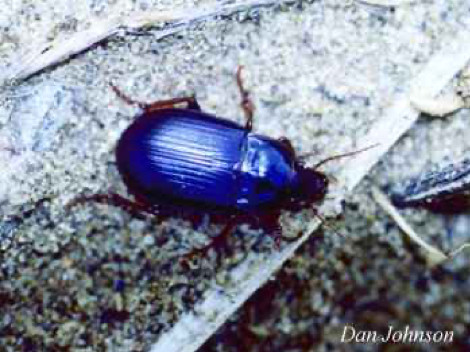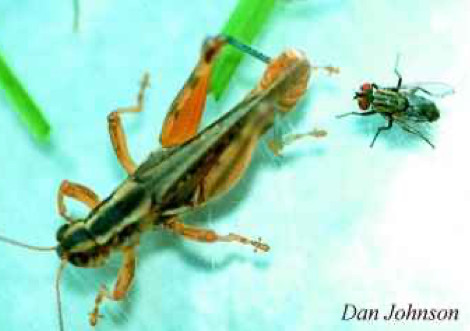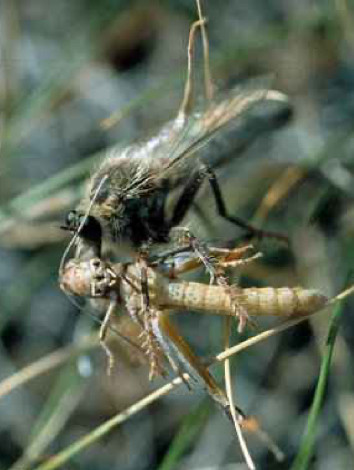Government mail service may be affected by the Canada Post labour disruption. Learn about how critical government mail will be handled.
Effects of weather
Temperature, rainfall and snowfall each play a major role in determining the severity of a grasshopper outbreak. Temperature is the most important factor determining the size of the spring grasshopper population. Warm days of the previous spring and summer determine how quickly the parents of the following year's grasshoppers develop and begin to lay eggs.
Fall temperatures
Climatic conditions in the fall are the limiting factors of successful egg laying and thus influence the number of eggs laid. Temperatures will also determine the extent of embryonic development, thereby affecting the time of hatching the following spring.
Winter temperatures
The effect of cold winter temperatures on grasshopper egg survival is minimal. Experiments conducted at the Lethbridge Research Centre have demonstrated that eggs can survive at -15oC. Soil temperatures in the field rarely fall below -10oC. Any effect on reducing egg survival would require conditions of wind, no snow cover and temperatures of -40oC for a number of days.
Spring temperatures
Spring temperatures have only a minimal effect on the survival of the grasshoppers that hatch. Young grasshoppers are hardy enough to survive low, even below freezing spring temperatures, providing these temperatures do not persist for several days. The most important aspect of spring temperature is its effect on the grasshopper development and plant growth. If the spring is hot, grasshoppers will hatch early and develop quickly. Cool spring temperatures will slow development. Crop development is also affected by less than ideal temperatures.
Rainfall
The relationship between temperature and rainfall controls the amount of crop damaged by grasshoppers. Under hot, dry conditions, a small grasshopper population may do as much damage as a large grasshopper population will under cool, wet conditions.
Moisture may also influence the size of the grasshopper population. During an extended drought, lack of water may slow the development of many eggs and can destroy eggs, especially during certain embryonic stages and just before hatching (eclosion). However, it has to be extremely dry before the grasshopper embryo begins to die under drought conditions .
Rainfall may affect a localized grasshopper population to a lesser extent. Rainfall will only have an effect if a heavy downpour occurs immediately after an extensive hatch. However, a cool, wet June will not seriously affect grasshopper populations.
The main effect of cool, wet weather is two-fold. It serves to:
- Reduce crop losses by hindering grasshopper development.
- Increase the possibility of disease in the grasshopper population, thereby helping to reduce next year's grasshopper population.
Natural enemies
Next to weather, natural enemies are the most important grasshopper population control factor. In some localized areas, natural enemies may cause even more grasshopper mortality than the weather. Some enemies attack grasshopper eggs in the soil while others attach to the nymphal and adult stages of the grasshopper.
Since most of the natural enemies of grasshoppers are already widespread, it is unlikely they could be used to prevent grasshopper outbreaks over extensive areas. Such a strategy would only succeed if these natural enemies were cultured and distributed in larger numbers, a very expensive operation.
Nevertheless, natural enemies do control localized grasshopper infestations and hasten the decline of grasshopper outbreaks.
Egg predators
Among the most important egg predators are bee flies, blister beetles, ground beetles (Figure 1) and crickets.
Common field crickets eat the grasshopper eggs, destroying up to 50% of the eggs in some areas. Bee flies and blister beetles deposit their eggs in the soil near grasshopper eggs. When the larvae of these egg predators hatch, they locate the grasshopper egg pods and feed upon them. If bee flies and blister beetles are abundant, they may destroy up to 80% of eggs in a localized area.
Spiders, some wasps and many birds feed on grasshoppers and consume large numbers of nymphs and adults. Their effect on the total grasshopper population is not known.

Figure 1. The ground beetle is an important grasshopper egg predator, actively seeking and feeding on grasshopper egg pods.
Nymphal and adult predators
Spiders (Figure 2), robber flies (Figure 4), some wasps and many birds may feed on grasshoppers and consume them in large numbers. However, the effect of these predators on the total grasshopper population is not fully known.

Figure 2. Banded garden spider preparing to feed on a grasshopper.

Figure 3. This sarcophagid fly (Blaesoxipha atlanis) is about to deposit a larva directly on a Packard’s grasshopper (part of an experiment by T. Danyk). The larva will burrow into the grasshopper to feed internally and will leave only when fully developed and ready to pupate.
Predatory birds
Gulls, hawks, crows, meadowlarks, crowned larks, lark buntings, desert horned larks, shrikes, curlews, killdeer, partridges and cranes are all predators of grasshoppers. Many birds scratch up the egg cases, and have been credited with clearing from 5 to 150 acres of grasshopper pods. Birds, especially gulls and meadowlarks, are credited with stopping some infestations in the early part of the century. This is more likely to happen if a habitat provides food and refuge for the birds. Farm habitat can be made more attractive to birds and so encourage predation of insect pests.
Vertebrates other than birds
Most animals are opportunists; they will eat what is nourishing and available to them. Mice, rats, shrews, gophers and badgers all eat grasshoppers and their egg pods. Coyotes, skunks, lizards, snakes, toads, bobcats and kit foxes eat nymphs and adults.
Egg parasites
A few other insects, such as the tiny wasps of the genus Scelio, parasitize eggs just after they have been laid. The young parasitic larvae complete their development within the eggs in time to emerge as adults and parasitize the eggs of the next generation of grasshoppers. They can destroy from 5 to 50% of the grasshopper eggs.
Nymphal and adult parasites and diseases
This group contains a large number of natural enemies including sarcophagid (flesh) flies (Figure 3), muscoid flies, tachinid flies, tangled vein flies, threadworms, fungi, micro-sporidians, and numerous others.

Figure 4. Grasshoppers can fall prey to robber flies, one of which has just captured this white whiskers grasshopper, Ageneotettix deorum.
Fly larvae either burrow into the grasshopper when they come into contact with it on the ground. Other fly larvae are deposited on or into the grasshopper's body by the female fly. The fly maggot then feeds inside the grasshopper and eventually kills its host as the maggot leaves the body. This group of insects may parasitize up to 60% of the grasshopper nymphs and adults.
‘Threadworms’ are frequently found coiled inside grasshoppers. The threadworms overwinter in soil and lay their eggs on the soil or on vegetation. Threadworms attack grasshoppers if the young larvae encounter a grasshopper or if grasshoppers eat threadworm eggs.
The fungus, Entomophaga grylli, can effectively control grasshoppers under warm, humid conditions. This fungus may occasionally reach epidemic proportions. The disease leaves the corpses of its victims clinging to the stems of plants.
The naturally occurring microsporidian parasite, Nosema locustae, is also an effective enemy of grasshoppers. A grasshopper becomes infected if it eats contaminated vegetation or a diseased grasshopper. A grasshopper population infected with this organism may be reduced by as much as 60% in one year. It also reduces the number of eggs laid and restricts the movement of individuals and thus affects grasshopper populations. Perhaps the microsporidian parasite’s greatest potential as a biological control agent is for reducing food consumption; attempts to use it as a grasshopper control agent have shown only limited success.
Cultural control
Of all the methods available for grasshopper control, cultural control methods are generally the least expensive. These methods do not require additional or special procedures; they merely involve good management strategies and the proper timing of normal operations necessary in the production of a crop.
By modifying the grasshopper's environment at certain critical periods of its life cycle, a producer may reduce grasshopper numbers directly. They can at least affect their ability to reproduce.
Despite the advantages cultural control methods offer, many producers are reluctant to use them since it is difficult to assess their effectiveness. Nevertheless, these methods are effective if implemented well in advance of any insect attack. These methods take time to work. Cultural control is a preventive approach to insect control.
The principal cultural methods used to control grasshoppers include:
- early seeding of crops
- crop rotation
- tillage
- trap strips
Early seeding
Crops should be seeded as early as possible. Older plants that are growing vigorously can withstand more grasshopper feeding than younger plants, which are not well established. Although early seeding will not prevent crop damage entirely, it will reduce the amount of damage to crops and will allow more time for the producer to obtain and apply insecticides. Also, early-seeded crops mature early, and migrating grasshoppers are less likely to be attracted to them as they are to lush young foliage.
Crop rotation
Whenever possible, avoid seeding cereals on stubble fields heavily infested with grasshoppers. Cereals should be seeded on stubble fields only where soil moisture is adequate and where one or more applications of an insecticide over the entire field is economical.
Tillage
Cultivation of the soil is a cultural practice available to producers for the reduction of grasshopper populations. Using tillage to control grasshoppers has to be considered carefully, especially under drought conditions. Tillage controls grasshoppers primarily by eliminating the green plants on which grasshoppers feed. The practice is of little value if used for the sole purpose of physically destroying grasshopper eggs or exposing them to desiccation, predation birds and other predators. Excessive tillage is harmful in that it will reduce soil moisture levels and increase the risk of soil erosion.
Fall tillage to get rid of weeds from summerfallow during late summer and early fall will discourage female grasshoppers from depositing their eggs in these fields. Grasshoppers seldom lay eggs in clean summerfallow even when it has a heavy covering of trash. Similarly, thorough field cultivation immediately after harvest will help discourage grasshoppers from laying all their eggs in the field.
It is advisable to complete early spring tillage or chemical fallow to eliminate all green growth on stubble fields before the grasshoppers have hatched. If no food is available for the young grasshoppers to eat when they hatch, they will starve. Early tillage also provides additional benefits: it gives good weed control and conserves moisture at no extra cost.
Tillage can be used as a last resort in fields where there are defined ‘hot spots,’ that is, where the young grasshoppers are continuing to hatch in large numbers and continued chemical applications are not desirable. In this situation, the tactic is to bury the eggs and hatching grasshoppers deep enough so that the young hoppers cannot make it to the surface.
Trap strips
If grasshoppers are present when tillage operations begin, it is possible to achieve adequate control by simply eliminating all green plant materials in a field. Once grasshoppers have fed and developed to the second stage of growth (second instar) in a field, they are usually mobile enough to move to adjacent crops when their existing food supply is exhausted. In these fields, trap strips should be used to collect grasshoppers into a relatively small area. It will then be possible to control the insects quickly and economically using a minimum amount of insecticide.
To make trap strips (Figure 5.), cultivate a black guard strip 10 m wide around the outside of a field. Leave an unworked green strip of at least 10 m before resuming cultivation (Figure 5). Repeat the process as often as necessary to produce additional trap sites.
All green vegetation must be eliminated between the trap strips if they are to be effective. The black guard strip is enough to ensure that grasshoppers will move promptly into the trap strips to feed. However, this trap strip does not have enough vegetation to feed a large grasshopper population for more than 1 or 2 days.
Trap strip effectiveness can be improved considerably by seeding the strips to wheat or spring rye several weeks before tillage begins. The migration of young grasshoppers from the cultivated guard strips to the trap strips may take several days.
Once the migration is complete, the trap strips and a 10 m strip of any adjacent crop should be treated with an insecticide. The young grasshoppers are very susceptible to insecticides. The highest application rate recommended for the insecticide used should be applied to ensure adequate control is achieved.
Before cultivating the trap strips, wait 3 days to assess the effectiveness of the insecticide. If adequate control is not achieved after 3 days, it may be necessary to treat the trap strip again. When grasshoppers have been eliminated from the trap strip, it should be possible to complete tillage without fear of displacing large numbers of grasshoppers into the adjacent crops.

Figure 5.Trap strip around the perimeter of a field.
Chemical control
It is important to control grasshoppers before they become winged. A good size is 7 to 16 mm in length, or ½ to ¾ of an inch. Once they become winged, they are much harder to kill.
Talk to your neighbours. Try to get large groups of farmers in one area to agree to control the grasshopper populations. This way the grasshoppers won't migrate from their unsprayed land onto yours.
Avoid spraying when it is really hot. At higher temperatures, they can metabolize the chemical faster and some chemicals won't be nearly as effective. At higher temperatures there is also increased spray evaporation. Avoid spraying when it is cold, as the grasshoppers may be near the ground surface under the canopy trying to stay warm, making it harder to reach them with the chemical.
The ideal temperature range for spraying grasshoppers is 20 to 25 degrees Celsius; most chemicals fit into this range and the grasshoppers should be active. Check the label for the temperature range of whatever chemical you are using to maximize its effectiveness.
If you are having your crops sprayed by an aerial applicator, it may be beneficial to pay for a little extra water volume to ensure that you have good coverage of the area that you are spraying.
It is important to be realistic. If you have high population numbers, even with a 90% kill with an insecticide there may be numbers left that are still higher than the thresholds. Be aware of this. It might not be that the chemical is not working; it could just be that your numbers were high to start with.
Different chemicals have different residual times. If this is important check this the label.
Make sure the insecticide that you are using is registered for that crop. Registered crops can be found in Alberta’s Crop Protection Guide.
Insecticides may harm beneficial insects needed to pollinate some crops. For this reason, avoid spraying when the crop is in bloom.
Pasture and grazing considerations
Each insecticide has a different interval for the length of time that cattle have to be left out of the treated field before grazing. It can range from accessing the field immediately after application to waiting up to 14 days after application.
When applying insecticide to pasture or hay land, check to make sure that the insecticide is registered for all species of forage in the mix.
Ecobait applicators
Check with your local chemical dealers. They may be able to direct you to a spreader.